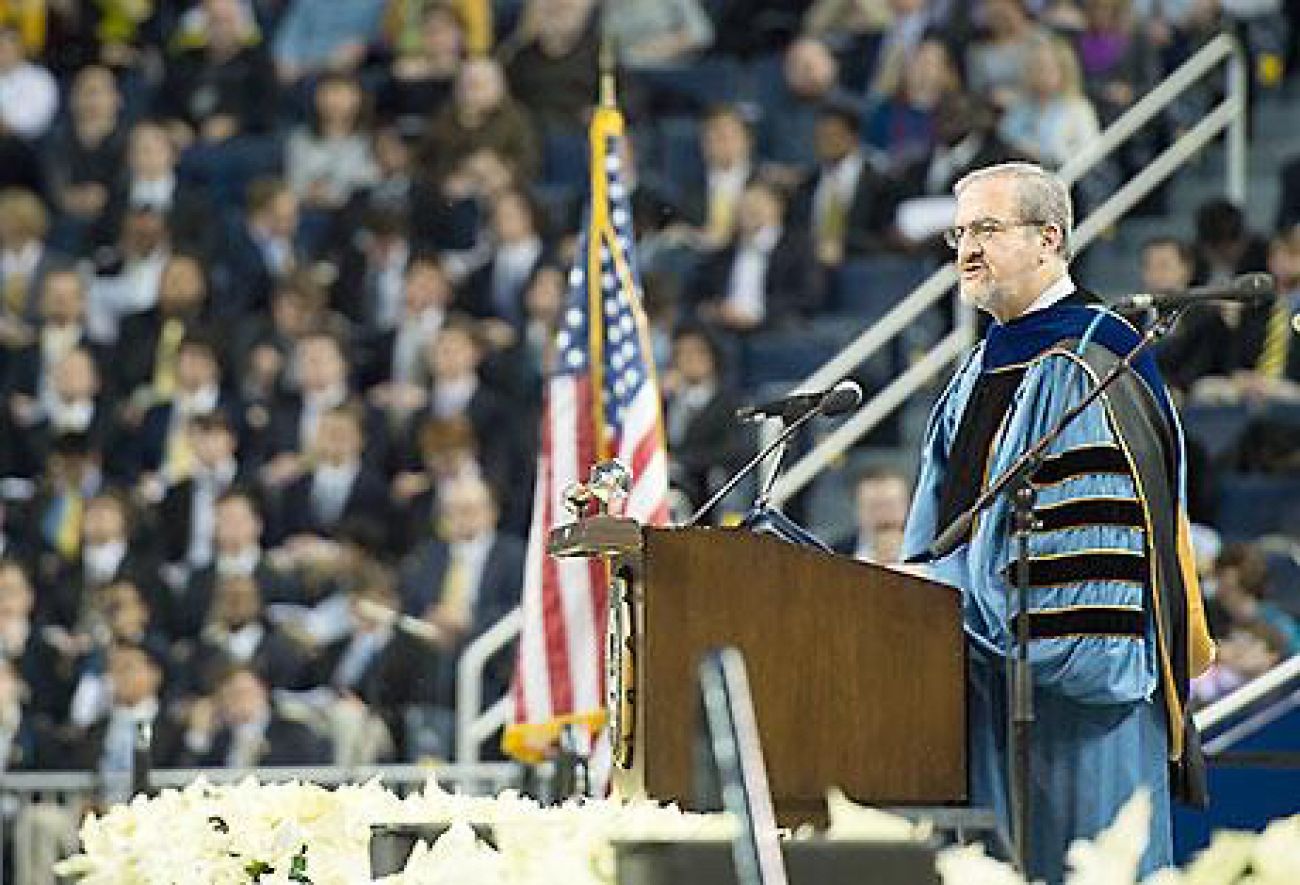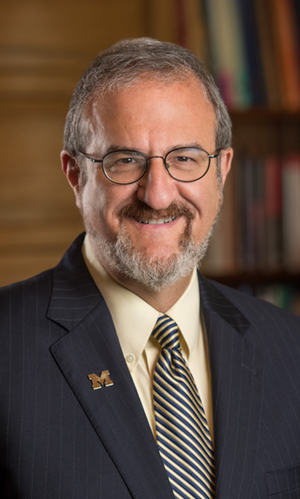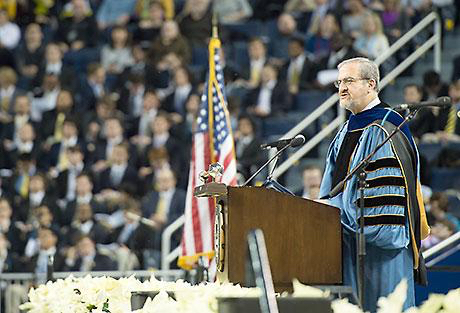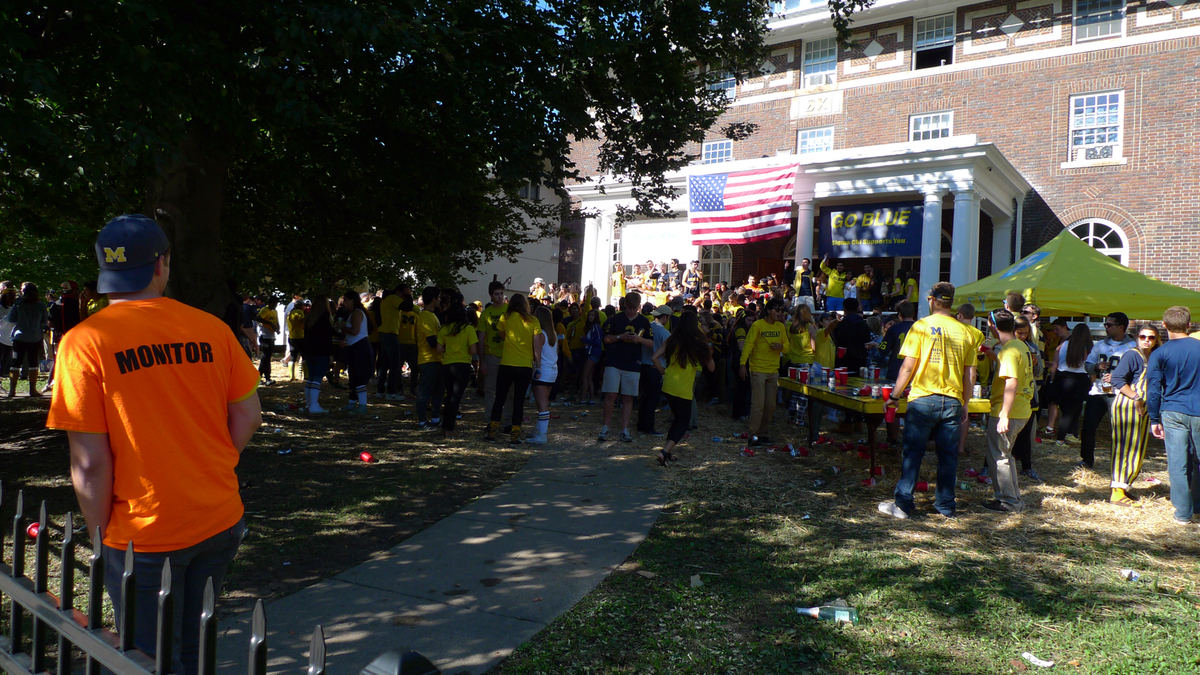Settled into U-M’s top job, Mark Schlissel strategizes its future

When Dr. Mark Schlissel, a physician-scientist, became president of the University of Michigan in July 2014, he laid out a sweeping vision in his inaugural address – to “commit to research and teaching that meet the most pressing needs of our global society” and to nurture a broad and diverse community in the process. It’s an ambitious agenda, at a time when state support of higher education has flagged, and rising costs have made college access and affordability a pressing concern for students and their families.
Schlissel recently sat down with Bridge Editor David Zeman, staff writer Nancy Derringer and Center for Michigan (and former U-M regent) founder Phil Power to discuss issues of interest to the university and its community. The following Q-and-A has been edited and condensed.
BRIDGE: Let’s start by talking about diversity. Do you have any specific plans for increasing the number of African-American students attending – and especially graduating from – U-M? What is the most innovative way, given the restraints of Proposal 2 (the 2006 state constitutional amendment that banned consideration of race in university admissions), that you can use to accomplish that?
It’s extremely important to us as a community, and to me personally, that we build a learning and teaching and researching and staffing community that looks like the state we serve. We can’t achieve academic excellence without tapping into the richness and diversity of the society we’re embedded in.
We start with the notion, supported by evidence, that talent is pretty uniformly distributed throughout the population. There’s no credible evidence that children growing up in poor communities are less talented than children growing up in wealthy communities. Our challenge, as educators wanting to build a community of talented students, is finding ways to reach out and identify where talent is.
There’s a long history of relying, or perhaps over-relying, on standardized test scores. Standardized tests are a legitimate measure of how a student does on a standardized test (and) there are tons of data correlating socioeconomic status and how well you do on them. We need to be able to look more deeply, to use criteria that evaluate every applicant in a holistic way, in the context of what opportunities they have in their environment, how they’ve taken advantage of them, what traits of character and grit and stick-to-it-tiveness they’ve shown, how they’ve optimized their ability to function in the community they’re in. And that’s what we do, all around the state of Michigan.
We’re trying to figure out better ways to do this all the time.
HAIL to the lower-income applicant
One of our big challenges here is, I think a lot of talented kids of lesser means don’t apply because they’re scared to. They don’t think they can survive in what appears from the outside to be an elite, wealthy community. So we’re trying to increase the number of applicants and create more socioeconomic diversity through this mechanism.
We’ve started a scholarship program called the HAIL scholarship – (for) high-achieving involved leaders. We’ve partnered with 257 high schools around the state, asking teachers to identify their best students. We’re looking for low-income students. We’ve collected 1,000 of them, and we have another group of 1,000 who are a control group.
These are high-school seniors that we think may be talented enough to do well at U-M, based on recommendations from school leaders, and (there’s a) subset who are from lower socioeconomic groups. We invite them to apply; we proactively reach out. We send them a voucher that assures them they won’t have to pay to apply. We send information about how to fill out the forms. And we tell them that if they get accepted – and they have to go through the process just like anybody else – we’ll guarantee them at least a four-year, full-tuition scholarship.
The second 1,000 kids are sent a letter inviting them to apply, and that’s it. That’s the control group.
After a couple of years, we’ll look to see what kind of students we’re getting out of these two groups, who follows through with the application process, and of the kids who get accepted, which ones say yes.
We’re not allowed to use race or ethnicity in deciding whom to admit, but what we can do is make aggressive efforts with getting them to say yes once we’ve admitted them. We’re also working hard with all our students, not just the HAIL scholars, to get financial aid decisions, and admission decisions, out at the same time.
BRIDGE: What does that cure?
Imagine being a family that makes $35,000 a year. Your kid is a sponge for knowledge, they’d be so thrilled to come to Michigan, they get the thick envelope and dad looks and says, “$14,000 in tuition?” And he looks at his two other kids, and he cries.
We’re going to have to change the way we represent our financial aid, too, because most people don’t get it. If you come from a family that makes less than $70,000 a year, U-M is free. You don’t pay tuition. I really want to convince students all around the state that of course they’re good enough to come to the University of Michigan. And of course they can afford it. That’s part of our efforts to diversify.
We’re really trying to get the message out, all across the state, that this is their public university, whether you’re in the nice suburbs of Detroit, or Grand Rapids, or up in the Midland area, or the Upper Peninsula. We find a way to make it work for your family. Your only part is to fill out the darn application and get in.
BRIDGE: There are certainly those who would like U-M to accept fewer kids from out of state. They see it as a money grab, denying many more Michigan students than are currently accepted their opportunity. What’s the argument for keeping it where it is?
The current freshman class is about 42 or 43 percent out-of-state. I certainly think we shouldn’t exceed half. But it’s really a juggling act. Geography is a type of diversity. Having a kid from California, from New York, from Florida and from Texas in your living suite? There are big differences between those parts of the country.
If the state had the wherewithal and will to bring their contribution to education up where it used to be, then the university would have the ability to look harder and deeper and broader across the state. We’re getting slightly less than $300 million a year to the Ann Arbor campus, and that’s roughly similar to what the Ann Arbor campus got in 1997, not adjusted for inflation.
In the era where higher ed was a shared value for society, and a common good, 60-70 percent of the cost of education was being paid by the state.
‘Magical thinking’
BRIDGE: Some are pushing back on that argument, and talk about the bloat in administration. Which brings us to affordability. The Center for Michigan’s last engagement campaign found significant concern among state residents around the issue of affordability. Gov. Snyder has said he believes Michigan higher-ed institutions need to be more efficient and customer-focused. With the legislature we have, more money for higher ed is probably not forthcoming. What do you think of Snyder’s suggestions?
The idea that the public shouldn’t have to invest in higher education is magical thinking. It sounds great, administrative bloat is a wonderful thing to point to, but our rate of growth in the administration is less than our rate of growth in faculty, less than our rate of growth of students. We’ve cut tens of millions of dollars from the administrative side of the house. And we can keep going, and we are.
The surprising things that drive costs are something we should think about. I’m in a global competitive market for faculty. People didn’t bat an eye when we had to pay for (football) Coach Harbaugh, and they shouldn’t bat an eye when we have to pay for an outstanding physicist, or English professor, or visual artist.
And we house perhaps a third of our students in university-owned housing, and the vast majority of others live in pretty darn close proximity to campus. We’re responsible for lots of aspects of students’ lives that we wouldn’t be if they were living at home. We’ve made large and increasing investments in student psychological services. We have the challenges of sexual misconduct.
A lot of our learning goes on outside the classroom. So it’s not just students sitting in a lecture and writing a paper, it’s students sitting in a cafeteria, arguing and discussing. It’s clubs, and programs. So these things have costs. We have a huge physical infrastructure. That’s our responsibility to maintain. Technology costs keep going up. To think that the public can get a world-class education for the same contribution the public as a whole was willing to make 20 years ago is magical thinking.
Defending research universities
BRIDGE: You mentioned several times the research aspect of U-M. As you know, places like Wisconsin and North Carolina have conservative legislatures that want to cut back on that. There’s a notion that, you’ve got good professors, so put them in front of students. It’s an appealing argument; we’re paying for our kids to go there, we want Professor Famous Guy.
Well, they are getting Professor Famous Guy. All our faculty teach, the vast majority teach undergraduates. We use very relatively low numbers of adjunct faculty. Higher education in the United States is a remarkable thing; we lead the world. One of its most remarkable features is how many different types of institutions there are, everything from community colleges and trade schools up to four-year colleges, all the way to research universities – big schools, small schools, religious schools, schools that use the great books only. So this diversity of educational opportunity is amazing.
Parents ask me what’s special about U-M, why they should send their kid to a big research university? When you learn at a research university, you’re learning from the faculty who are defining what the frontiers of knowledge are, people who are framing the questions that will define human ambition and what we’ll know in the future. It’s a very different style of learning, and you also have the opportunity to intellectually engage with these faculty.
In addition, at a research university, students get to work with scholars in their research. I ran an immunology lab for 20 years, and I’d always have undergrads in the lab. It was great – they’d learn, they’d produce science, they’d test out careers. They’d learn that learning isn’t just the receipt of information, it’s thinking, framing questions and being creative with information.
Wisconsin and other states that are going to an extreme – Texas has argued to do this – they’re heading for long-term trouble. They’re headed for lesser-competitive generations of students. Who else does discovery research in our society? The companies aren’t doing it anymore; there’s no value proposition. So if it’s not research universities that are driving the knowledge economy, the state’s really going to suffer.
BRIDGE: So the false premise in what they’re saying is that it’s a zero-sum game between being in the classroom and being a research university?
The nature of research is such that it enriches teaching. And the research itself provides opportunities for students to participate in discovery of knowledge and creation in interesting, novel ways. It’s not for everybody, but it’s why you come to U-M.
Alcohol and its disruptions
BRIDGE: People are still talking about the fiasco at Treetops (where a fraternity weekend resulted in extensive damage to a northern Michigan resort). A lot of people in the Greek system seem to think you want to put them on a leash or shut them down. What are your plans for reining them in and curbing their worst excesses, while still capitalizing on the good things they do?
The Greek institutions are part of Michigan’s culture, and many universities’ culture. About 20 percent of our students are members of a fraternity or sorority. It’s a significant, but not predominant, part of the university residential experience. Greek life isn’t the only place these problems exist, and a lot is fueled by alcohol, and perhaps other things, and that’s what keeps me up at night. It happens outside of Greek life, too, so I don’t want to give the false impression that if one “fixed” Greek life, then students would be safe and no one would be at risk from alcohol toxicity.
The second thing to say is, as I’ve learned more about Greek life, there are huge advantages to those who participate. We’re a big university, and one of the keys to success for students is to find a way to make it feel smaller. Fraternities and sororities give kids a sense of belonging in a smaller universe that gives them the security to go out and deal with the other 43,000 students here. Their academic averages are higher than the campus as a whole. Their service programs, volunteerism, is higher than the typical student’s. There are a lot of good things about Greek life.
I was absolutely mortified and angered by (the Treetops incident). I was incredibly upset by it. I think it was a wakeup call for Greek life. Multiple Greek organizations were sanctioned, some were not allowed to recruit, which is the death penalty for them. We’ll see what happens. If they can clean up their acts, they can start recruiting again in subsequent years.
Not just as a result of that, we’ve begun more intense efforts on campus to work with the leadership of the Greek houses, with alumni, with the home organizations, to curb the risk behavior and reinforce these positive things. One of the things I learned is, the students in the (houses) are sophomores. They do their pledge business freshman year, they live in the house sophomore year, and usually juniors and seniors are off in the community, living in private houses with friends. The president of the fraternity is often a sophomore, so you’re asking a sophomore to be the responsible person in a residential community full of other sophomores feeling their independence. It’s a lot.
BRIDGE: Do you think that culture’s really changing?
I think we have the attention of the Greek community, but I don’t know the extent to which behavior is changing. All the fraternities and sororities have to undergo additional education in alcohol and sexual misconduct and peer intervention. Many are being trained as sobriety monitors. Our campus police has begun more closely collaborating with the Ann Arbor Police Department, because they’re not on university property. I think an effort to stop 18- to 21-year-olds from violating the law (with, say, an open beer) is doomed to failure. But I would hope we can develop an enforcement mechanism to prevent students from drinking so much that their health is in peril.
BRIDGE: So there’s a determined shift in policy from minor-in-possession enforcement to binge drinking?
What the public-safety people will do is look for people who appear unsafe because they’ve been drinking. Having a beer and walking down the street may be illegal, but as an enforcement matter, it’s not the student walking down the street, it’s the one lying against a tree and it’s 30 degrees and they’re wearing a T-shirt and a hat.
(Finally), we’re trying something we were loathe to do. For freshmen who’ve had their second alcohol violation, we’re contacting mom and dad. We debated this because we want students to seek help when they run into trouble. And we were concerned they might be less likely to seek help if we thought we would call their parents. But the problem’s not getting any better, so we want to try new things. So far, we’ve notified about 120 parents.
We’re looking at best practices elsewhere, and evidence-based approaches. I’m a biology guy, so I have a pretty low threshold for trying something new, measuring whether it’s working, continuing it at scale if it is, shutting it down if it isn’t, and trying something different.
Michigan Education Watch
Michigan Education Watch is made possible by generous financial support from:
Subscribe to Michigan Health Watch
See what new members are saying about why they donated to Bridge Michigan:
- “In order for this information to be accurate and unbiased it must be underwritten by its readers, not by special interests.” - Larry S.
- “Not many other media sources report on the topics Bridge does.” - Susan B.
- “Your journalism is outstanding and rare these days.” - Mark S.
If you want to ensure the future of nonpartisan, nonprofit Michigan journalism, please become a member today. You, too, will be asked why you donated and maybe we'll feature your quote next time!


 Mark Schlissel became the University of Michigan-Ann Arbor’s 14th president in July 2014, after serving as provost at Brown University. (Courtesy photo)
Mark Schlissel became the University of Michigan-Ann Arbor’s 14th president in July 2014, after serving as provost at Brown University. (Courtesy photo) President Mark Schlissel addresses graduates and guests at the December 2015 winter commencement ceremony. (Photo by Eric Bronson, Michigan Photography)
President Mark Schlissel addresses graduates and guests at the December 2015 winter commencement ceremony. (Photo by Eric Bronson, Michigan Photography) A sober monitor guards the gate at a fraternity party on a football Saturday last fall; measures to curb alcohol abuses were increased after a vandalism incident involving U-M fraternities last year. (Bridge photo by Nancy Derringer)
A sober monitor guards the gate at a fraternity party on a football Saturday last fall; measures to curb alcohol abuses were increased after a vandalism incident involving U-M fraternities last year. (Bridge photo by Nancy Derringer)